It’s been about six weeks since cracks started forming and chunks started falling off the busy Springwater path south of OMSI. Since then, the damage has worsened and as rain continues to fall, the Portland Parks & Recreation bureau is still a bit nervous about what might happen next.
After constant monitoring of the riverbank beneath the path by geotech engineers, Parks announced this morning that path users should expect delays on Tuesday, May 1st, as engineers take a closer look. Here’s more from the official statement:
“… from the SE Ivon entrance to about mile 2. Workers, equipment and vehicles will be on site as engineers address recent riverbank erosion, caused by heavy rains and high water. Bikers and joggers please take note…”
I rolled by the damage 10 days ago and here’s how it looked…
Losing this link in our transportation network would be a big deal. I’ll keep you posted if I hear of any more significant closures or damage.


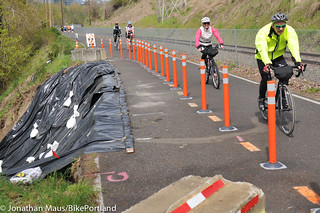
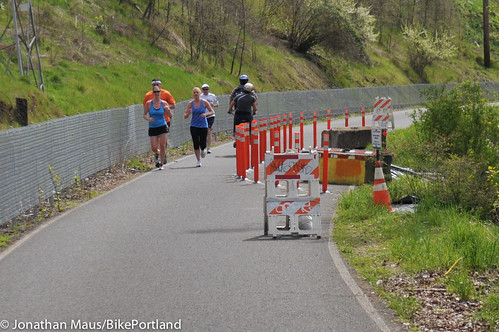
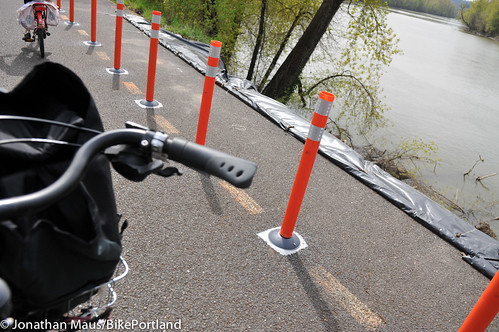

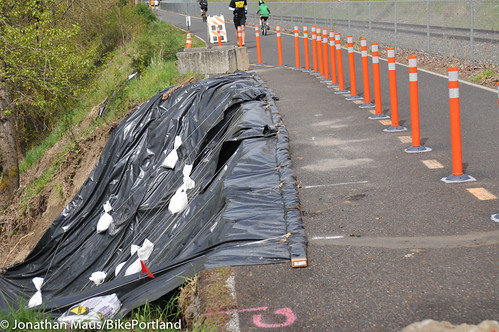
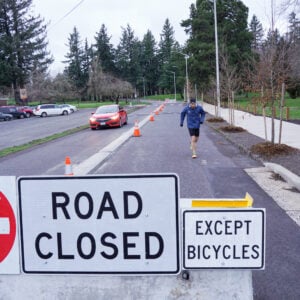


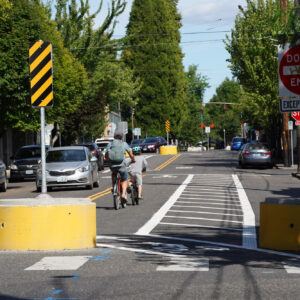
Thanks for reading.
BikePortland has served this community with independent community journalism since 2005. We rely on subscriptions from readers like you to survive. Your financial support is vital in keeping this valuable resource alive and well.
Please subscribe today to strengthen and expand our work.
“path users should expect delays on Tuesday, May 1st, as engineers take a closer look”
“…as engineers address recent riverbank erosion”
Jonathan, do you interpret this language to mean that by May 1 they expect to have fixed the problem, or finished assessing it?
That black plastic is completely cosmetic and will do nothing to prevent continued erosion.
I think the black plastic is there to protect our eyes from what is really there. When I saw this area most recently the black tarp wasn’t there, and about half of the path is completely hollowed out underneath! It’s essentially an asphalt shell with nothing underneath supporting it! This area seems like an accident just waiting to happen and thus I’ve been avoiding the path and taking an alternate route.
The plastic will prevent rain from washing additional soil down the slope, now that the vegetation is completely gone. Additionally, it will help prevent a potential slide by limiting soil saturation.
http://en.wikipedia.org/wiki/Causes_of_landslides
the soil on that slope will saturate from upslope groundwater seepage, and keeping the rain off does nothing to limit the amount of groundwater entering those soils. Plus the river is rising again, which is going to cause more saturation and erosion at the toe of the slop;, the black plastic is completely ineffective at stopping either of these two things from happening.
Given your day job, BURR, I’m not inclined to argue with you on this one – you’re probably more knowledgeable on that subject than most Bikeportland commenters.
Yes, those are the major factors at work here. But saying that the black plastic does nothing is false, as it does prevent rain erosion.
And as others have pointed out, it provides a sense of comfort by hiding the problem and making people think that they are doing something about it.
Thanks for the update, Jonathan. This is my beautiful, beloved commute route. The people driving to and from work on Hwy 99E, just up the hill, have no clue that I can pull over and watch deer grazing in a meadow.
And keeping half the trail closed, even for a very short distance, gets problematic as the weather improves and we have more people using the trail. I’ve already seen runners, walkers, bikers and rollerskaters trying to negotiate that bottleneck together.
When you say “losing” you mean temporarily, yes? I’ve been looking at homes lately and have considered a few near the mouth of the Springwater trail at the river. I wouldn’t consider moving that far south if access to the trail went away altogether. Temporarily, I could deal with.
It could be more significant than that, depending on the damage, the underlying soil condition, etc. The interesting thing is that if the railroad were still in its original location, it would be the tracks having the issue rather than the path. (Oregon Pacific’s tracks were moved in order to install the path) Continued erosion in that location may still jeapordize the railroad, and would definitely close the path. It’s debatable whether either the railroad or the city has the financial resources necessary to do major stabilization work in that area.
Mother Nature bats last.
the actual quote (by Annie Dillard in Tinker at Pilgrim Creek) is “Nature bats last” and it comes at the end of a lengthy section on the spectacularly horrific ways that the natural world achieves balance–Dillard does a great job of resisting the “mother” moniker for earth as she sees the relationship between human and earth more complexly. The quote is, in fact more perfect given the situation at the river–the river doesn’t give a crap about our commute!
As time marches on, the river is going to keep eating away at the Springwater. Time to sink some piers there to stop the erosion.
Float it like the East Bank Esplanade.
True though it may be that “nature bats last”, the rhetoric about earth’s disregard for tiny humans is a huge leap, if not hijack from the topic of an erosion problem. At Riverview Cemetery the entire hillside is sliding at the location of the Sellwood bridge. An engineered solution of a line of deeply drilled concrete columns that anchor to bedrock is being built. The tiny scarp at the trail is not a battle scar from human’s war on “mother nature” . It is an erosion problem that can be solved with the result that the trail will remain in service for a long time to come.
And when Nature pitches, the strike zone is whatever she says it is.